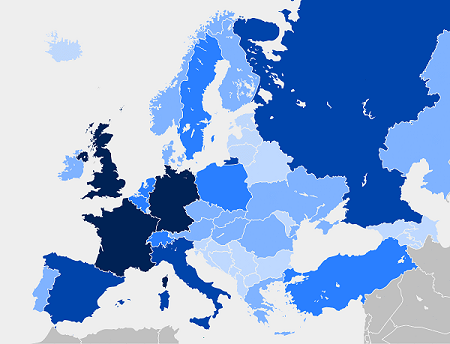Project Introduction
Problem description
Year 2020 was undoubtedly dominated by the pandemic caused by the new SARS-CoV-2 coronavirus. The pandemic has created many challenges for governments, enterprises and society globally. All countries in the world have been affected by the illness. Some of them have been hit harder than the others. As a healthcare worker who works in the hospital, I had great interest in all information about development of this disease, and I was especially concerned about situation in Europe.
In every country in the world governments had to make difficult decision how to save public health from COVID illness. Were they successful? Which EU countries were hit the most with Covid cases and deaths? Did high numbers of hospital beds and healthcare workers helped in keeping low number of patient’s deaths? Is there any correlation between countries with low GDP and higher number of COVID cases? Did school closures and restriction of movement make any difference keeping the low number of cased? Were population with higher median age in worse situation through out the year of pandemic? There are a lot of questions and I would like to find answers for some of them.
 Abadonend Berlin Central Station
Abadonend Berlin Central Station
Project Scope
The scope of “Covid cases in Europe” Project is to identify patterns, common elements among European Union countries with high and low number of Covid new cases and new deaths. This project will target health system elements, selected demographic, economical characteristics and internal countries policies. In project scope:
- • Project will target only current European Union countries.
- • Project will target period of time between 2020-01-03 and 2021-05-03.
- • Project will target only the following elements of demographics characteristics: GDP per capita ( USD), median age.
- • Project will target only the following elements of healthcare system characteristics: hospital beds, nurses and midwives, physicians per 1000 population.
- • Project will target two specified internal restrictions: School closures , internal movement restrictions for each day in the period, where "0" -no restrictions and "3"- highest restriction.
Dataset Sources
COVID Cases & Deaths
Dataset have been provided by World Health Organization website in .csv format. Original dataset contains number of new cases, cumulative cases, and new deaths and cumulative deaths. Dataset has a minimum amount of missing data and contains worldwide daily data. In my project I use number of new cases and deaths and they will be recalculated to show cases and deaths per 10 000 population.
Source Link: WHO COVID-19 Data
 Covid-19 Test Tube
Covid-19 Test Tube
Economical and demographic datasets
Economical dataset of “GDP” , “population” have been sourced from the WorldBank website and imported as .csv files.Demographic data of “Median Age” has been scrapped from the website to show ability to find different HTML components, to use BeautifulSoup module and to import elements into .csv file for data analysis.
Source Link: World Bank Population Data
Source Link: World Bank GDP Data
Scraped Data: World Data Median Age

Healthcare dataset
Three major factors to be considered when analysing healthcare services in each European countries are: available hospital beds, amount of nursing staff and number of physicians per 1000 population. Best website to acquire all necessary data is World Bank where the relevant data is being collected since 1960.
Source Link: World Bank Hospital Beds Data
Source Link: World Bank Nurses Data
Source Link: World Bank Physicians Data

Internal policies dataset
Probably the most curious case and also the subject that create a lot of controversy is impact of the lockdown policies and strategies on flattening COVID-19 cases curve. After some research, I've found two relevant datasets. First one shows when schools were closed in each European country, second one refers to movement restrictions. Both of them can be found in "Our World in Data" dataset collection.
Source Link: Our World in Data Policy Responses Data
